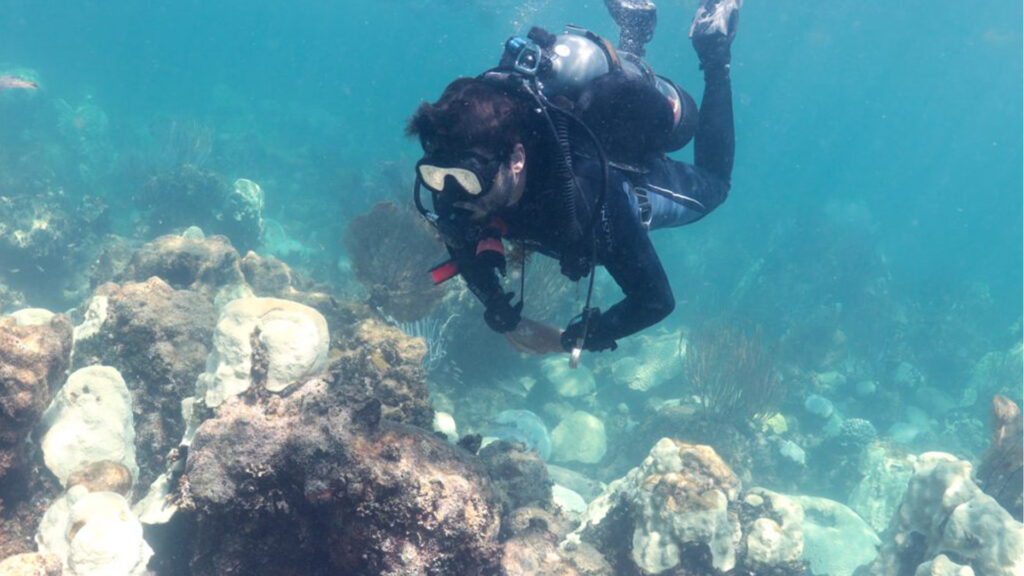By Rebecca Vega Thurber, UCSB Marine Sciences Institute
The Trump administration has cut jobs and funding for scientific research and National Oceanic and Atmospheric Administration (NOAA) climate monitoring, which together have led a global effort to reverse the ongoing, rapid and devasting losses of marine habitats, including coral reefs. As a marine scientist, I am particularly concerned about the future of U.S. coral reefs when science and management budgets are cut even as sustained funding is desperately needed, now more than ever, to study, protect and rebuild these habitats.
Starting in the 1980s, American coral reefs first succumbed to massive disease outbreaks, and then to bleaching and mortality events driven by climate change. These two factors, as well as others like pollution, caused loss of more than 50% of coral species, with many of the U.S.’s once abundant corals now on the endangered species list. This means that reefs are in peril now.

Yet globally, only $250 million has been spent on international coral reef restoration, despite estimates that coral reefs are worth upwards of $2.7 trillion to the international economy per year. What’s more, these precious resources are only found on about 350,000 square kilometers of our planet. Without sustained funding to safeguard and regenerate these biodiverse, culturally significant and economically valuable places, we will lose what is left of them, not in the next generation, but in this one.
Despite our northern location, the U.S. hosts many tropical coral reefs, including in Florida, Hawaii, Puerto Rico, the U.S. Virgin Islands and Guam, to name just a few. Reefs provide $100 million in extractive resources, like commercial shellfish and finfish each year. Furthermore, U.S. reefs provide hundreds of thousands of American jobs through tourism and recreation. The healthy reefs in the Florida Keys alone yield $6.3 billion in revenue every year.
Coral reefs also protect American coastlines from storm and tidal surge. A 2021 U.S. Geological Survey report found that reefs provide $1.8 billion in coastal flood protection. This same study proposed that an investment of just $3 million per kilometer in reef restoration could fully protect Floridian and Puerto Rican coasts from future damage. Amazingly, the costs of this restoration would be recouped in a single year due to the reduction in flood impacts, which becomes all the more essential as climate change causes sea-level rise and increases the frequency and severity of hurricanes.
In 2015, the U.S. government committed $255 million for restoration efforts to preserve our failing coral reef species. By many accounts, several goals have not been met and many restoration efforts have failed, though not for lack of ingenuity or integrity. Due to a shocking series of extreme heat waves, particularly one in 2023 that bleached 77% of the world’s reefs, many regional programs lost years of effort. However, several federal programs allowed scientists and managers to save, study and raise breeds of corals that may be critical in preserving reefs in the future. Protected areas and state parks have assisted with natural adaptation and created essential tools to predict the timing and location of bleaching events that give locals time to intervene.

Government and nonprofit funding also led to the development of innovative approaches such as thermally resistant corals, disease intervention strategies and artificial reef formation, which together can assist wider coral habitat and species restoration efforts.
The U.S. should do the smart and right thing by continuing to invest in state-of-the-art and effective American reef research and restoration. The U.S. Coral Reef Task Force, a group representing multiple agencies, states and territories, is meeting this month, and it must not only aim to renew the U.S. commitment but expand it considerably. The U.S. contains about 22,000 square kilometers of coral reef, yet their financial worth is in the billions economically. Their intrinsic value is incalculable. A quadrupling of our past 2015 investment of $1 billion is a small and modest ask in light of what the U.S. may lose.
In the event the current administration withdrawals or reduces its support, philanthropies, global scientific foundations and everyday citizens should come together to legislatively and financially support solutions-based science and restoration programs that ensure a productive and sustainable future for American coral reefs.
Rebecca Vega Thurber is a professor of ecology, evolution and marine biology and the director of the Marine Sciences Institute of the University of California Santa Barbara. She is the winner of the 2024 International Coral Reef Society’s Mid-Career Award. This opinion piece was originally published by the Sun Sentinel, which is a media partner of The Invading Sea. Banner photo: A diver snorkeling around Florida’s Coral Reef near Key West (iStock image).
Sign up for The Invading Sea newsletter by visiting here. To support The Invading Sea, click here to make a donation. If you are interested in submitting an opinion piece to The Invading Sea, email Editor Nathan Crabbe at nc*****@*au.edu. To learn more about coral bleaching, watch the video below.




Very informative! Happy for the update.